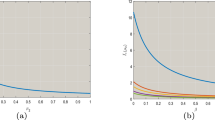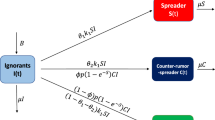Abstract
Rumors or wrong information are always spread in different spatial locations by virtue of various available media. Therefore, the propagation ability of rumors or wrong information should be different in different geographical locations. In this paper, we report the dynamical behaviors of a diffusive SI (susceptible-infected) type rumor propagation model in a spatially heterogeneous environment. In view of the fact that rumor-refuting is a common phenomenon in the real world, we introduce this concern in the rumor propagation model. We first derive the properties of uniform boundedness and permanence of the rumor propagation model. These results indicate that the rumor propagation model has at least one rumor-spreading steady state. Thereafter, the asymptotic profiles of the rumor-spreading steady state are reported. We thus find that such rumor-spreading steady state exists if one of the migration rates of the rumor-infected individuals or the rumor-susceptible individuals tends to zero and infinity, respectively. Our theoretical results reveal that this rumor propagation model can admit wealthy dynamical profiles in a spatially heterogeneous environment. Some numerical results are also presented in order to check the theoretical conclusions.





Similar content being viewed by others
Data Availibility Statement
There is no associated data in this manuscript.
References
Daley, D.J., Kendall, D.G.: Epidemics and rumours. Nature 204, 1118 (1964)
Sahafizadeh, E., Ladani, B.T.: The impact of group propagation on rumor spreading in mobile social networks. Physica A 506, 412–423 (2018)
Pastor-Satorras, R., Castellano, C., Mieghem, P.V., et al.: Epidemic processes in complex networks. Rev. Mod. Phys. 87, 925 (2015)
Wang, Y., Wei, Z.C., Cao, J.D.: Epidemic dynamics of influenza-like diseases spreading in complex networks. Nonlinear Dyn. 101, 1801–1820 (2020)
Jia, F.J., Lv, G.Y., Zou, G.A.: Dynamic analysis of a rumor propagation model with Lévy noise. Math. Methods Appl. Sci. 41, 1661–1673 (2018)
Zhang, Y.H., Zhu, J.J.: Dynamics of a rumor propagation model with stochastic perturbation on homogeneous social networks. J. Comput. Nonlinear Dyn. 17, 031005 (2022)
Indu, V., Thampi, S.M.: A nature-inspired approach based on forest fire model for modeling rumor propagation in social networks. J. Netw. Comput. Appl. 125, 28–41 (2019)
Myilsamy, K., Kumar, M.S., Kumar, A.S.: Optimal control of a rumor model with group propagation over complex networks. Int. J. Mode. Phys. C 32, 2150035 (2021)
Dong, S., Huang, Y.C.: A class of rumor spreading models with population dynamics. Commun. Theor. Phys. 70, 795–802 (2018)
Tian, Y., Ding, X.J.: Rumor spreading model with considering debunking behavior in emergencies. Appl. Math. Comput. 363, 124599 (2019)
Zehmakan, A.N., Galam, S.: Rumor spreading: a trigger for proliferation or fading away. Chaos 30, 073122 (2020)
Chen, J., Hu, M.B., Li, M.: Traffic-driven epidemic spreading dynamics with heterogeneous infection rates. Chaos Solit. Fract. 132, 109577 (2020)
Choi, W., Ahn, I.: Effect of prey-taxis on predator’s invasion in a spatially heterogeneous environment. Appl. Math. Lett. 98, 256–262 (2019)
Ni, W.J., Shi, J.P., Wang, M.X.: Global stability of spatially nonhomogeneous steady state solution in a diffusive Holling–Tanner predator-prey model. Proc. Am. Math. Soc. 149, 3781–3794 (2021)
Chen, M.X., Wu, R.C.: Dynamics of diffusive nutrient-microorganism model with spatially heterogeneous environment. J. Math. Anal. Appl. 511, 126078 (2022)
Li, S.B., Wu, J.H.: Asymptotic behavior and stability of positive solutions to a spatially heterogeneous predator-prey system. J. Differ. Equ. 265, 3754–3791 (2018)
Chen, J., Cao, J.D., Li, M., et al.: Optimizing protection resource allocation for traffic-driven epidemic spreading. Chaos 32, 083141 (2022)
Tarboush, A.K., Ge, J., Lin, Z.G.: Asymptotic periodicity in a diffusive West Nile virus model in a heterogeneous environment. Int. J. Biomath. 10, 1750110 (2017)
Lou, Y., Wang, B.: Local dynamics of a diffusive predator-prey model in spatially heterogeneous environment. J. Fix. Point Theor. Appl. 19, 755–772 (2017)
Zhu, L.H., Huang, X.Y., Liu, Y., Zhang, Z.D.: Spatiotemporal dynamics analysis and optimal control method for an SI reaction-diffusion propagation model. J. Math. Anal. Appl. 493, 124539 (2021)
Hess, P.: Periodic-Parabolic Boundary Value Problems and Positivity. Longman Scientific & Technical Harlow, New York (1991)
Zhu, S.Y., Wang, J.L.: Asymptotic profiles of steady states for a diffusive SIS epidemic model with spontaneous infection and a logistic source, Commun. Pure. Appl. Anal. 19, 3323–3340 (2020)
Gilbarg, D., Trudinger, N.: Elliptic Partial Differential Equation of Second Order. Springer, New York (2001)
Chen, M.X., Wu, R.C.: Patterns in the predator–prey system with network connection and harvesting policy. Math. Methods Appl. Sci. 46(2), 2433–2454 (2023)
Chen, M.X., Wu, R.C., Wang, X.H.: Non-constant steady states and Hopf bifurcation of a species interaction model. Commun. Nonlinear Sci. Numer. Simul. 116, 106846 (2023)
Zhang, J.L., Cui, R.H.: Qualitative analysis on a diffusive SIS epidemic system with logistic source and spontaneous infection in a heterogeneous environment. Nonlinear Anal.: RWA 55, 103115 (2020)
Weinberger, H.F.: Invariant sets for weakly coupled parabolic and elliptic systems. Rend. Mat. 8, 295–310 (1975)
Le, D.: Dissipativity and global attractors for a class of quasilinear parabolic systems. Commun. Part Differ. Equ. 22, 413–433 (1997)
Peng, R., Zhao, X.Q.: A reaction–diffusion SIS epidemic model in a timeperiodic environment. Nonlinearity 25, 1451–1471 (2012)
Magal, X.P., Zhao, Q.: Global attractors and steady states for uniformlly persistent dynamical systems. SIAM J. Math. Anal. 37, 251–275 (2005)
Zhao, X.Q.: Uniform persistent and periodic coexistence states in infinite-dimensional periodic seminows with applications. Can. Appl. Math. Q. 3, 473–495 (1995)
Lou, Y., Ni, W.M.: Diffusion, self-diffusion and cross-diffusion. J. Differ. Equ. 131(1), 79–131 (1996)
Chen, M.X., Wu, R.C., Xu, Y.C.: Dynamics of a depletion-type Gierer–Meinhardt model with Langmuir–Hinshelwood reaction scheme. Discrete Contin. Dyn. Syst. B 27(4), 2275–2312 (2022)
Lei, C.X., Li, F.J., Liu, J.: Theoretical analysis on a diffusive SIR epidemic model with nonlinear incidence in a heterogeneous environment. Discrete Contin. Dyn. Syst. B 23(10), 4499–4517 (2018)
Du, Y., Peng, R., Wang, M.X.: Effect of a protection zone in the diffusive Leslie predator–prey model. J. Differ. Equ. 246, 3932–3956 (2009)
Nie, Y.Y., Li, W.Y., Pan, L.M., et al.: Markovian approach to tackle competing pathogens in simplicial complex. Appl. Math. Comput. 417, 126773 (2022)
Nie, Y.Y., Zhong, X.N., Lin, T., et al.: Pathogen diversity in meta-population networks. Chaos Solit. Fract. 166, 112909 (2023)
Acknowledgements
The authors express their sincere gratitude to the anonymous referee for her/his careful reading and helpful suggestions which led to great improvements of the presentation of this paper. This work was supported by the China Postdoctoral Science Foundation (No. 2021M701118).
Author information
Authors and Affiliations
Contributions
MC: formal analysis, writing-original draft, review and editing, project administration. HMS: writing-original draft, review and editing. All authors reviewed the manuscript.
Corresponding author
Ethics declarations
Conflict of interest
The authors declare that they have no known competing financial interests or personal relationships that could have appeared to influence the work reported in this paper.
Additional information
Publisher's Note
Springer Nature remains neutral with regard to jurisdictional claims in published maps and institutional affiliations.
Rights and permissions
Springer Nature or its licensor (e.g. a society or other partner) holds exclusive rights to this article under a publishing agreement with the author(s) or other rightsholder(s); author self-archiving of the accepted manuscript version of this article is solely governed by the terms of such publishing agreement and applicable law.
About this article
Cite this article
Chen, M., Srivastava, H.M. On a Rumor Propagation Model with Spatial Heterogeneity. Qual. Theory Dyn. Syst. 23, 1 (2024). https://doi.org/10.1007/s12346-023-00858-0
Received:
Accepted:
Published:
DOI: https://doi.org/10.1007/s12346-023-00858-0




